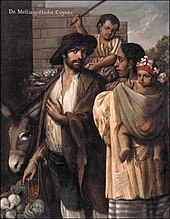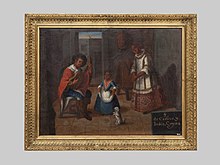
Mestizo is a person of mixed European and indigenous non-European ancestry in the Spanish Empire. In certain regions such as Latin America, it may also refer to people who are culturally European even though their ancestors are indigenous. The term was used as an ethno-racial exonym for mixed-race castas that evolved during the Spanish Empire. It was a formal label for individuals in official documents, such as censuses, parish registers, Inquisition trials, and others. Priests and royal officials might have classified persons as mestizos, but individuals also used the term in self-identification.

Casta is a term which means "lineage" in Spanish and Portuguese and has historically been used as a racial and social identifier. In the context of the Spanish Empire in the Americas, the term also refers to a 20th-century theoretical framework which postulated that colonial society operated under a hierarchical race-based "caste system". From the outset, colonial Spanish America resulted in widespread intermarriage: unions of Spaniards, Amerindians, and Africans. Basic mixed-race categories that appeared in official colonial documentation were mestizo, generally offspring of a Spaniard and an Indigenous person; and mulatto, offspring of a Spaniard and an African. A plethora of terms were used for people with mixed Spanish, Amerindian, and African ancestry in 18th-century casta paintings, but they are not known to have been widely used officially or unofficially in the Spanish Empire.

Torna atrás or tornatrás is a term once used in 18th century Casta paintings to portray a mestizo or mixed-race person who showed phenotypic characteristics of only one of the "original races", such as European or Amerindian ancestry. The term was also used to describe an individual whose parentage was half white and half "albino".

Castizo is a racial category used in 18th-century Colonial Mexico to refer to people who were three-quarters Spanish by descent and one-quarter Amerindian. The feminine form of the word is castiza. In the early 21st century, the term castizo has also come to mean mixed-race people with light skin, in comparison to mulattos, pardos, and coyotes, who would be mixed-race people with darker skin.

Miguel Mateo Maldonado y Cabrera (1695–1768) was a Mestizo painter born in Oaxaca but moved to Mexico City, the capital of Viceroyalty of New Spain. During his lifetime, he was recognized as the greatest painter in all of New Spain. He created religious and secular art for the Catholic Church and wealthy patrons. His casta paintings, depicting interracial marriage among Amerindians, Spaniards and Africans, are considered among the genre's finest. Cabrera's paintings range from tiny works on copper to enormous canvases and wall paintings. He also designed altarpieces and funerary monuments.
Gente de razón is a Spanish term used in colonial Spanish America and modern Hispanic America to refer to people who were culturally Hispanicized. It was a social distinction that existed alongside the racial categories of the sistema de castas. Indigenous peoples, who maintained their culture and lived in their legally recognized communities, and mixed-race people, especially the poor in urban centers, were generally considered not to be gente de razón.

Juan Rodríguez Juárez was an artist in the Viceroyalty of New Spain. He was a member of a Spanish family long noted for their accomplishments in the world of painting. His brother was Nicolás Rodríguez Juárez (1667–1734), who was like himself, an established painter in New Spain. He was the son of Antonio Rodríguez (1636–91), a notable Spanish painter. His maternal grandfather José Juárez (1617–1661) and maternal great great grandfather Luis Juárez (1585–1639) were also notable painters in Spanish history and prominent in the Baroque era.

Luis de Mena was a Mexican artist who lived and worked predominantly in the middle of the eighteenth century. Mena painted religious works and has been described as "no more than a journeyman painter in 18th century Mexico." He signed a work entitled "Most Holy Mother of Light", now on display in the Serra Museum in San Diego, California.
While the Casta system was flourishing in New Spain (1519-1821), a painters' guild emerged in order to classify the different ‘races’. The painters' guild in New Spain paralleled the structure, purpose, and mobility of the Casta system they were representing.
Relaciones geográficas were a series of elaborate questionnaires distributed to the lands of King Philip II of Spain in the Viceroyalty of New Spain in North America. They were done so, upon his command, from 1579–1585. This was a direct response to the reforms imposed by the Ordenanzas, ordinances, of 1573.
An unpublished manuscript entitled Ordenanzas del Baratillo de México was signed and dated in 1754 by Pedro Anselmo Chreslos Jache, likely a pseudonym for an educated Spaniard. It is a satirical piece of eighteenth-century colonial literature written in New Spain, which sought to offer an alternative view of life in colonial Spanish America.

Francisco Clapera (1746–1810) was a Spanish painter who after training in Spain lived and worked in Colonial Mexico. Here he was one of the few foreign painters to create casta paintings, a distinctive Mexican genre that depicts in sets of consecutive images scenes of racial mixing among the Indians, Spaniards and Africans who lived in the Spanish colony.
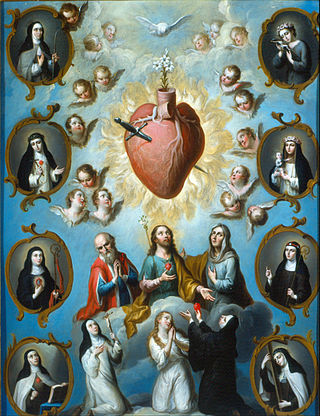
Juan Patricio Morlete Ruiz was an 18th-century Mexican painter, a mestizo according to the system of racial classification. He is most well known for his casta paintings.

Pardos is a term used in the former Portuguese and Spanish colonies in the Americas to refer to the triracial descendants of Southern Europeans, Indigenous Americans and West Africans. In some places they were defined as neither exclusively mestizo, nor mulatto, nor zambo. In colonial Mexico, pardo "became virtually synonymous with mulatto, thereby losing much of its Indigenous referencing". In the eighteenth century, pardo might have been the preferred label for blackness. Unlike negro, pardo had no association with slavery. Casta paintings from eighteenth-century Mexico use the label negro, never pardo, to identify Africans paired with Spaniards.

José de Páez (1720–1790) was a Mexican painter of religious images, a history painting of the destruction of Mission Santa Cruz de San Sabá in Texas, and a set of casta paintings in the 18th century. He was of Baltazar de Páez, José is identified student of Nicolás Enríquez. He married Rosalía Caballero in 1753.
The ideas of the Spanish Enlightenment, which emphasized reason, science, practicality, clarity rather than obscurantism, and secularism, were transmitted from France to the New World in the eighteenth century, following the establishment of the Bourbon monarchy in Spain. In Spanish America, the ideas of the Enlightenment affected educated elites in major urban centers, especially Mexico City, Lima, and Guatemala, where there were universities founded in the sixteenth and seventeenth centuries. In these centers of learning, American-born Spanish intellectuals were already participants in intellectual and scientific discourse, with Spanish American universities increasingly anti-scholastic and opposed to “untested authority” even before the Spanish Bourbons came to power. The best studied is the University of San Carlos Guatemala, founded in 1676.
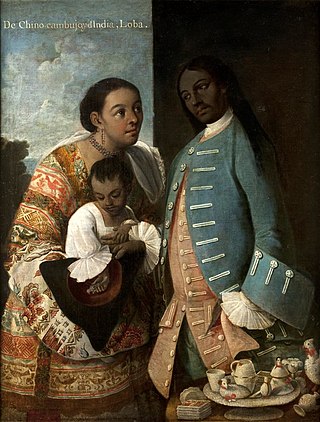
Lobo is a racial category for a mixed-race person used in Mexican paintings illustrating the caste (casta) system in 17th- and 18th-century Spanish America.
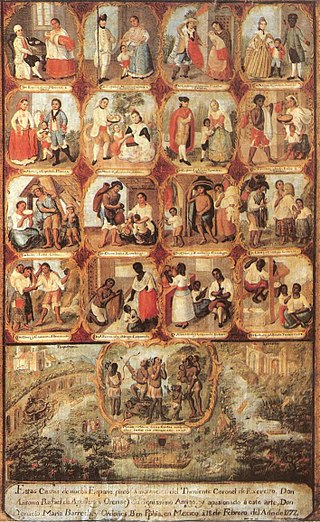
Ignacio María Barreda was an eighteenth-century Mexican painter, self-identified as university graduate with a Bachiller in philosophy. Mexican art historian Manuel Toussaint noted him for his portraits, including two of elite women, reproduced in his publication, and others of elite religious men. Toussaint believed he might be the official painter for the Seminario de San Camila, His 1777 single-canvas casta painting is an exemplar of this eighteenth-century genre of secular art. It is similar in some ways to the 1750 single-canvas painting by Luis de Mena, which also includes outdoor scenes near Mexico City, particularly the Paseo de Ixtacalco.

José Joaquín Magón was a late eighteenth-century Mexican painter from Puebla de los Angeles.

Chino was a casta term used in colonial Mexico to refer to people of mixed ancestry. In the eighteenth century, individuals of mixed Amerindian and African ancestry came to be called chinos.
